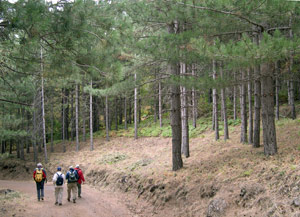Typical variegated landscape of Mediterranean woodland
The Woods  Bronte has a territory extraordinarily various and ample, one of the more extensive of Catania's province with 25.000 hectares and a height from 380 to 3350 meters. Bronte has a territory extraordinarily various and ample, one of the more extensive of Catania's province with 25.000 hectares and a height from 380 to 3350 meters.
Rich of vegetation, it is characterized by the majestic size of Etna that impend over the town, by green and fecund hills and high mounts that slope down sweetly towards the big valleys, where rivers and torrents flow (Simeto, Troina, Saraceno, Martello, Cutò). Represents a true catalogue of natural beauties distinguished by a singular alternation of vegetation and cultivations, both heterogeneous as luxuriant. Suggestive lava landscapes frame the agricultural cultivations, with valuable orchards, olive groves, pistachio fields, and centenary woods enriched by torrents and small lakes. You must go to Bronte to enjoy the most majestic view of mount Etna. Only in Bronte it appears in all the accord, in all the purity, in all the harmony of its most perfect and more solemn lines. The territory of bronte extends from the top of the Central Crater (3.350 m.) to that one of the Mount Soro (1847 m.) on the Nebrodi and falls inside the two wonderful park, of Etna (to which gives nearly 10.000 hectares) of the Nebrodi (3.871 hectares of which 1.495 in the zone A of integral reserve) and of the natural reserve of the Simeto lava grottos.
The woods of Bronte
 The woods of Bronte (put, in the parts not covered by lava, below Etna and, especially, on the Nebrodi) represent the typical variegated landscape of Mediterranean woodland and one of the last zones that still can give us at least an idea of what was once the appearance of Sicily. The woods of Bronte (put, in the parts not covered by lava, below Etna and, especially, on the Nebrodi) represent the typical variegated landscape of Mediterranean woodland and one of the last zones that still can give us at least an idea of what was once the appearance of Sicily.
It is a true mosaic of vegetal formations, a collection of trees, of bushes and flowers. Follow, one after the other pines, white birches (one of the symbolic tree species of Etna that grow spontaneously in the highest part of the woods) and centuries-old oaks, the helm-oak, the cork, the beech, the ash, the maple, the elm, the chestnut, the walnut, the cherry tree and even the wild pear tree, the thorn bush, the holly and the butcher's broom, the hawthorn, the broom, (important colonizer of recent lava). To the Nebrodi Park Bronte gives over 15% of its territory, with zones of singular importance as the well known Mangalaviti wood, the Grappidà forest, the formations of Serra del Re (1.754 m.) and Foresta Vecchia that represent, together to other woods of the entire park, the last testimonies of the island's green with presence of extremely specialized flora (the Beech, authentic wreck of the glacial era). The heterogeneity of vegetal formations and the presence of a great number of ecologic niches allow the existence of a true "Noah' ark" with a high faunal diversity with rich and complex animal communities. Even having to admit the disappearance of the mythical big mammals (deer, fallow deer, bear, roe deer, wild pig, wolf, griffon, etc.), the present fauna, in the woods of Bronte, has still a notable variety and quantity of animals and birds (only on the Nebrodi there are about 150 species of birds).
 Is not rare to see some of the animals that still live in these areas: the fox, the weasel, the marten, the wild cat, the dormouse, the porcupine, the curly, the musk rat (the "Felis silvestris silvestris"), the green lizard, the tortoise and the turtle; among the birds there are magpies, owls and hawks, crows, woodpeckers, woodcocks, partridges, falcons and kites. Is not rare to see some of the animals that still live in these areas: the fox, the weasel, the marten, the wild cat, the dormouse, the porcupine, the curly, the musk rat (the "Felis silvestris silvestris"), the green lizard, the tortoise and the turtle; among the birds there are magpies, owls and hawks, crows, woodpeckers, woodcocks, partridges, falcons and kites. In the area comprised between the mounts Ruvolo, Lepre and De Fiore, at the feet of Etna, has come back to nest and live the Royal Eagle, brought back in the territory, some years ago, by the Park authorities. Multicolored and diversified are the typical flowers of the underbrush; especially in spring, they dot the landscape with chromatic effects of rare suggestion. Many the flowers as the anemone, the butter cup, the asphodel, the sylvan violet, the astragal, the cyclamen, the soapwort, the peony rose, the canine rose, the primrose, the valerian (or "spezzaquartari)", the thistle, the chamomile. Most significant is the presence of some species of spontaneous orchids (vulgarly called "pizzingurdu"). Only in the woods and lava of Etna have been found more than 200 species of flowers, some exclusive to the volcano, rare or very rare in the territory.
|